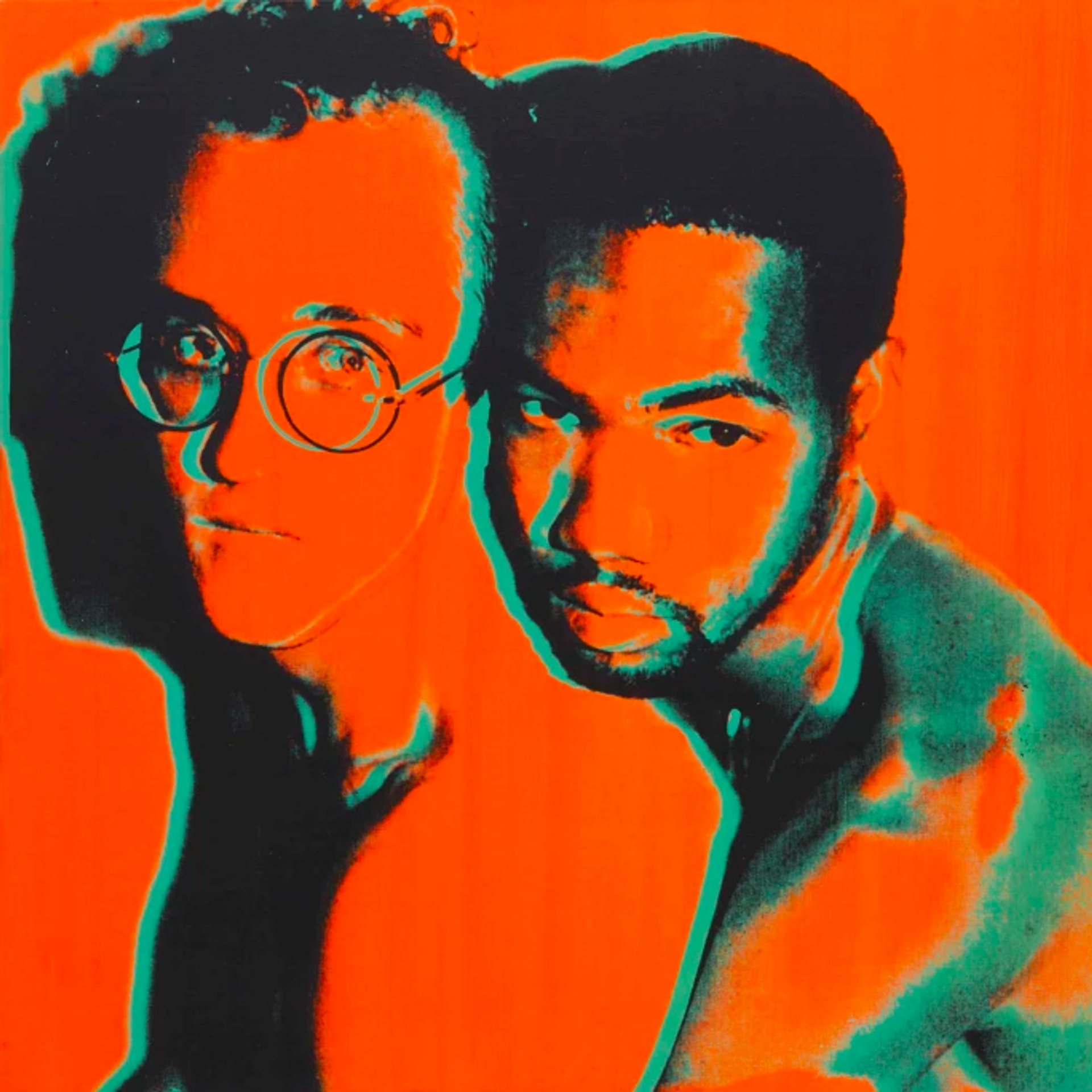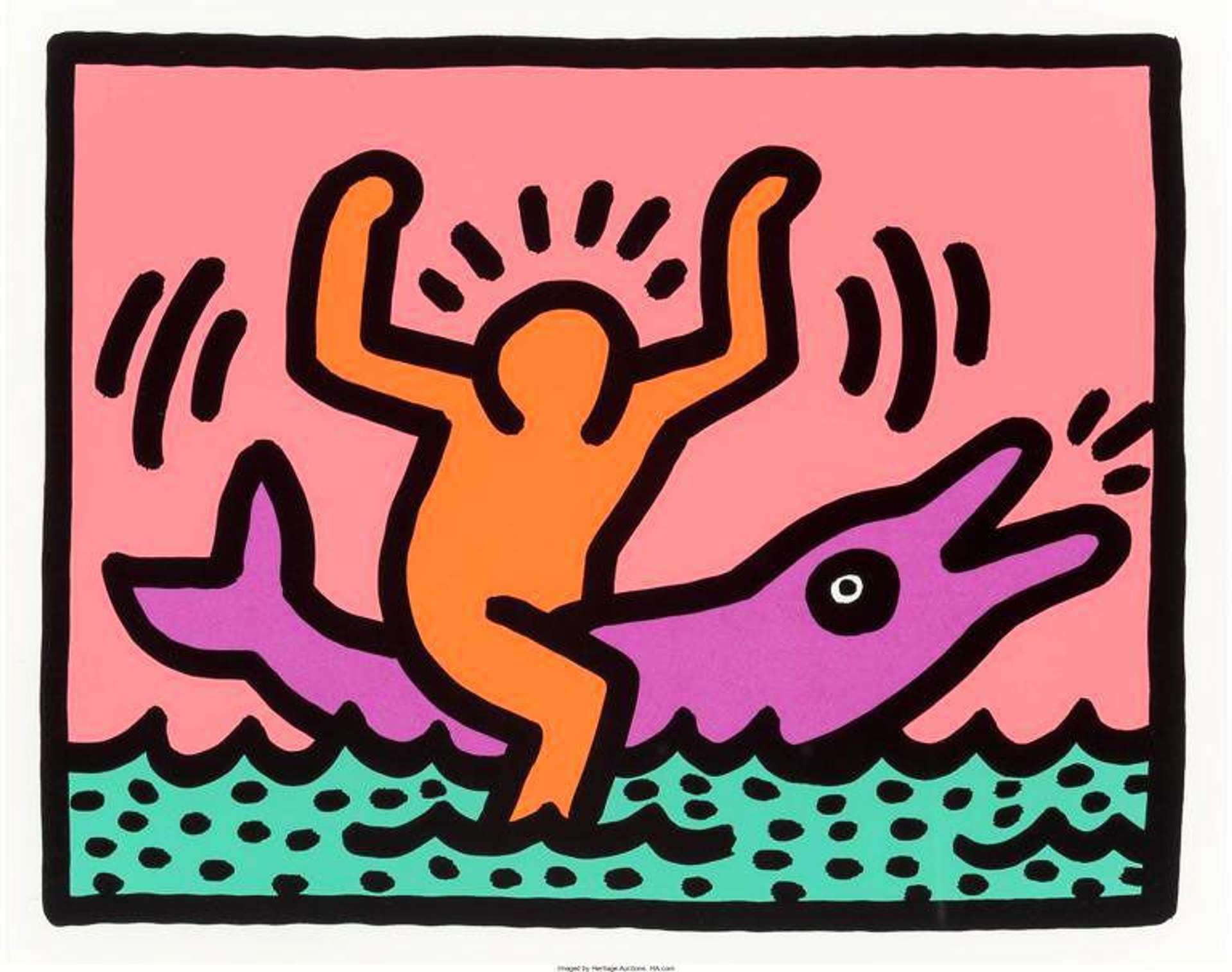 Untitled (Dance) © Keith Haring 1987
Untitled (Dance) © Keith Haring 1987
Interested in buying or selling
Keith Haring?

Keith Haring
250 works
Keith Haring created his own niche during the emergence and popularisation of American Street Art. His use of moving figures, energetic lines, and vivid colours captured the essence of movement and dance, infusing his art with a contagious spirit of joy and celebration.
The Artistic Context of Keith Haring’s Movement and Dance
Haring’s artistic journey was shaped by the diverse art movements of the 20th century. His unique style resonates with the vibrant energy of graffiti art, an influence he encountered in the bustling streets of New York City. It also draws inspiration from the bold aesthetics of Pop Art, with vibrant colours and dynamic lines reminiscent of artists like Andy Warhol. The spirit of street culture and hip-hop infuses his imagery, capturing the essence of urban life through dance, music and captivating visual narratives. Haring’s art stands as a testament to the convergence and innovation of these influential art movements, culminating in his expressive visual language.
Haring’s collaborations with influential musicians like Grace Jones and Madonna served as living testaments to his deep embrace of popular culture. Through these artistic partnerships, his creations transcended the confines of the art world, permeating the very fabric of cultural consciousness. Keith’s art fearlessly challenged the notion of exclusivity, celebrating the profound connective power of popular culture. His visually arresting works continue to captivate audiences, serving as enduring reminders of his visionary fusion of art and popular culture. His iconic figures, often depicted in energetic poses, exude a sense of rhythm and fluidity, mirroring the dynamic nature of dance. Haring's fascination with movement extended beyond his visual art, where he actively participated in the dance and club scene of 1980s New York.
The Significance of Haring's Untitled (Dance)
Haring’s Untitled (Dance) embodied the distinctive style and profound themes that defined the artist's career. The composition of Untitled (Dance) depicts exuberant figures burst forth in an ecstatic dance. Haring's renowned style takes centre stage, with his iconic bold lines and vibrant colours breathing life into these simple figures. They overlap, creating a mesmerising sense of unity and communal celebration. For Haring, dance was as a metaphor for life itself—a vessel through which freedom and human expression could be unleashed. The artwork exudes an infectious spirit of elation, welcoming viewers to embrace their own innate rhythms and join the vibrant festivities of existence. The interconnectedness of humanity, a recurring theme in Haring's body of work, finds expression in Untitled (Dance) that can symbolise the unbreakable bonds that bind us together as a collective.
Influenced by the constant rhythm of street culture, including breakdancing and hip-hop, Haring sought to capture the raw energy and spontaneity in these art forms. The animated poses and dynamic lines employed in his compositions of the dancing figures convey a sense of rhythm and uninhibited freedom.
 Pop Shop III © Keith Haring 1989
Pop Shop III © Keith Haring 1989Sound and Movement in Keith Haring’s Art: Dance Parties and more
Haring possessed a unique ability to infuse sound and movement into his creations, transcending the boundaries of visual art. Through his collaborative performances and installations, Haring not only engaged the viewer's visual senses, but also harnessed the power of sound to enhance the impact of his work.
Beyond the canvas, Haring actively incorporated sound and music into his performances and installations. In collaboration with DJ Larry Levan, he orchestrated his annual Party of Life events in 1984 at the Paradise Garage nightclub. The party wasn’t shy of celebrities, as Madonna made an appearance to debut two new songs from her upcoming album Like a Virgin. This wasn’t an unusual occurrence for the pair. Throughout both of their careers, the nature of their personal relationship poured over into their professional projects. At the second event one year later, Boy George graced the stage to sing Happy Birthday, drawing in a crowd that quite literally stopped traffic. To commemorate these celebrations, Haring produced silk screen tank tops and shorts as gifts for his friends.
 Image © Gallery 98 / The First Annual Party of Life at the Paradise Garage, Silk-Screened Tank Top © Keith Haring 1984 // Second Annual Party of Life at Palladium, Silk-Screened Tank Top © Keith Haring 1985
Image © Gallery 98 / The First Annual Party of Life at the Paradise Garage, Silk-Screened Tank Top © Keith Haring 1984 // Second Annual Party of Life at Palladium, Silk-Screened Tank Top © Keith Haring 1985By integrating sound into his art, Haring was able to create an environment that holistically engaged the viewer, blurring the line between passive observer and active participant. Furthermore he was no stranger to collaborating across disciplines. Haring was in charge of the set design for Secret Pastures, the 1984 performance merging stage and street. He also used Grace Jones as a subject to create a live canvas on her body, using body paint to adorn Jones with his rhythmic lines, patterns, and figures.
 Image © Cooper Hewitt / Bill T. Jones and Arnie Zane © Tom Caravaglia 1984
Image © Cooper Hewitt / Bill T. Jones and Arnie Zane © Tom Caravaglia 1984Keith Haring's Contribution to the Pop Art Movement
Pop Art emerged in the 1950s and 60s, challenging the norms of fine art while combining elements from mass media, consumerism, popular culture, and the iconography of everyday items. There’s an evident essence of this in Haring’s work, illustrated through his use of colour and bold lines which can echo an undertone of the flash and commercial appeal of media placements. The figures and symbols in his work were a mirror to the rich, bustling culture surrounding him at the time. Just as advertisements were displayed throughout subways and high-traffic areas, so was Haring’s art.
He integrated his work into fashion, music and dance, helping him to secure a well-deserved and respected role as a key figure in popular culture. Haring’s collaborations fostered a community of multidisciplinary artists, creating an inclusive environment that made space for dialogue, opening the doors to a more accessible art world. Haring launched Pop Shop in 1986 as a way for the public to engage with and purchase his artwork. He sold a variety of merchandise against the backdrop of his iconic moving figures and comic-like aesthetics.
Though Haring’s art provides an accurate reflection of what it means to be Pop Art, his greatest contribution to the movement is arguably his use of art as a form of activism. Haring’s work brought attention to drug abuse, the Cold War conflict, Apartheid, and the fight against HIV/AIDS.
You can learn more about Keith Haring's legacy here.
 Free South Africa 2 © Keith Haring 1985
Free South Africa 2 © Keith Haring 1985The Meaning of Dancing Figures in Keith Haring’s Art
Keith’s work engaged diverse audience groups, with much of his work being publicly displayed for worthy social causes. His art was a diary that revealed the complexities of his contemporaries and other marginalised communities. Although the creation of his artwork each speaks to a different message, they all share the movement motif. While we’re familiar with the concept of the figures displaying vibrancy, energy, and a sense of collectiveness, perhaps there’s more to uncover about the figures behind Haring’s most notable works.
Maybe he used movement and dance to maintain a degree of fun and optimism among the unheard voices he championed. Perhaps he used it to encourage viewers to take actual movement in leading warranted social change at the time.
We see different iterations of movements across his works like Pop Shop Quad III, and his Free South Africa series. While each piece holds their own style and meaning, it offers viewers an opportunity to ask themselves, “if there were no indication of movement, could the stories still be told the same way?”
Haring's Boundary-Breaking Legacy
Haring's art fearlessly challenged the notion of exclusivity, celebrating the profound connective power of popular culture. His vivid works continue to captivate audiences, serving as reminders of his visionary fusion of art and popular culture. His friend Madonna used Haring’s visuals in her Sticky and Sweet Tour backdrop video, ensuring his aesthetic lives on.
From the dancing figures that embody the universal language of movement to his collaborations that broke down barriers and expanded the reach of his art, Haring's artistic contributions resonate far beyond the art world, inspiring and engaging people from all walks of life. His legacy as a boundary-breaking artist continues to thrive, reminding us of the transformative power of art in forging connections, sparking conversations, and shaping the contemporary landscape.






